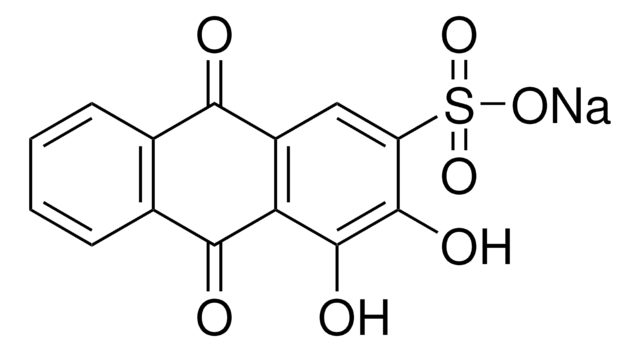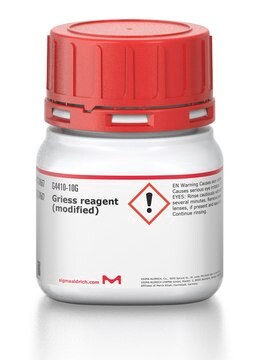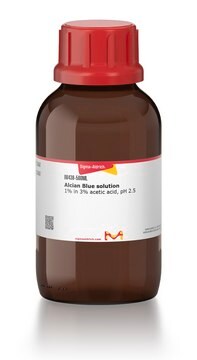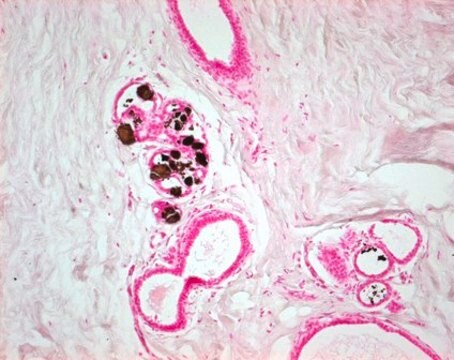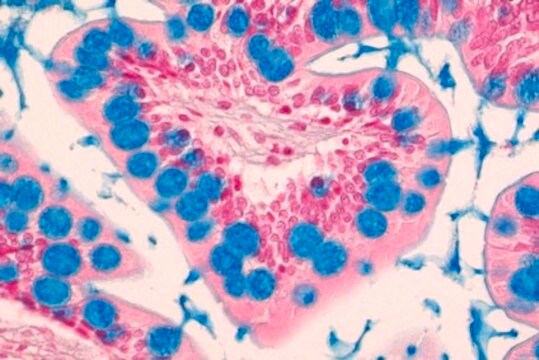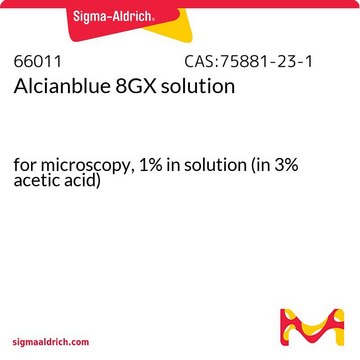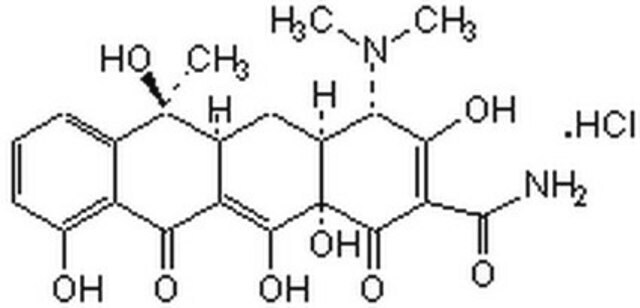1.06278
Alizarin red S mono sodiumsalt (C.I. 58005)
pH indicator
Sinónimos:
Alizarin red S mono sodiumsalt (C.I. 58005)
About This Item
Productos recomendados
Nombre del producto
Alizarin red S mono sodiumsalt (C.I. 58005), visual transition interval 4.3-6.3, yellow to pink, visual transition interval 9.4-12.0, brown-orange to violet
loss
≤10% loss on drying, 110°C
Quality Level
visual transition interval
4.3-6.3, yellow to pink
9.4-12.0, brown-orange to violet
Amax
418-424 nm (buffer pH 4.3
buffer pH 4.3
1 buffer pH 4.3)
444-450 nm (buffer pH 9.4)
510-517 nm (buffer pH 6.3)
554-558 nm (buffer pH 12.0)
storage temp.
2-30°C
SMILES string
[Na+].[S](=O)(=O)(O)c1cc2c(c(c1[O-])O)C(=O)c3c(cccc3)C2=O
InChI
1S/C14H8O7S.Na/c15-11-6-3-1-2-4-7(6)12(16)10-8(11)5-9(22(19,20)21)13(17)14(10)18;/h1-5,17-18H,(H,19,20,21);/q;+1/p-1
InChI key
HFVAFDPGUJEFBQ-UHFFFAOYSA-M
Categorías relacionadas
General description
Application
- A ratiometric fluorescence strategy based on inner filter effect for Cu(2+)-mediated detection of acetylcholinesterase.: This study utilizes Alizarin Red S to develop a fluorescence-based method for detecting copper ions and acetylcholinesterase activity, important for environmental monitoring and medical diagnostics (Li et al., 2021 doi:10.1007/s00604-021-05044-0).
- Multiplex SERS Chemosensing of Metal Ions via DNA-Mediated Recognition.: Explores the complexation of Alizarin Red S with different metal ions, utilizing Surface-Enhanced Raman Spectroscopy (SERS) for sensitive detection, which can be applied in environmental analysis and health sciences (Guerrini and Alvarez-Puebla, 2019 doi:10.1021/acs.analchem.9b02385).
- Capsicum-Derived Biomass Quantum Dots Coupled with Alizarin Red S as an Inner-Filter-Mediated Illuminant Nanosystem for Imaging of Intracellular Calcium Ions.: This innovative approach uses Alizarin Red S in a composite nanosystem for advanced imaging techniques to monitor intracellular activities, offering potential in biomedical research and diagnostics (Chen et al., 2018 doi:10.1021/acs.analchem.8b04055).
- Ratiometric fluorescent probe based on gold nanoclusters and alizarin red-boronic acid for monitoring glucose in brain microdialysate.: Highlights the application of Alizarin Red S in developing a glucose monitoring system, which is critical for understanding metabolic processes in neurological studies (Wang et al., 2014 doi:10.1021/ac5023293).
Analysis Note
1st transition range: pH 4.3 - pH 6.3 Lightly yellow - pink
2nd transition range: pH 9.4 - pH 12.0 Brown orange - violet
Absorption maximum λ 1 (buffer pH 4.3): 418 - 424 nm
Absorption maximum λ 2 (buffer pH 6.3): 510 - 517 nm
Absorption maximum λ 3 (buffer pH 9.4): 444 - 450 nm
Absorption maximum λ 4 (buffer pH 12.0): 554 - 558 nm
Spec. Absorptivity A 1%/1cm (λ1max; 0.01 g/l; buffer pH 4.3; calc. on dried substance): 135 - 180
Spec. Absorptivity A 1%/1cm (λ2max; 0.01 g/l; buffer pH 6.3; calc. on dried substance): 145 - 210
Spec. Absorptivity A 1%/1cm (λ3max; 0.01 g/l; buffer pH 9.4; calc. on dried substance): 170 - 230
Spec. Absorptivity A 1%/1cm (λ4max; 0.01 g/l; buffer pH 12.0; calc. on dried substance): 340 - 520
Loss on drying (110 °C): ≤ 10 %
Storage Class
11 - Combustible Solids
wgk_germany
WGK 3
flash_point_f
Not applicable
flash_point_c
Not applicable
Certificados de análisis (COA)
Busque Certificados de análisis (COA) introduciendo el número de lote del producto. Los números de lote se encuentran en la etiqueta del producto después de las palabras «Lot» o «Batch»
¿Ya tiene este producto?
Encuentre la documentación para los productos que ha comprado recientemente en la Biblioteca de documentos.
Los clientes también vieron
Nuestro equipo de científicos tiene experiencia en todas las áreas de investigación: Ciencias de la vida, Ciencia de los materiales, Síntesis química, Cromatografía, Analítica y muchas otras.
Póngase en contacto con el Servicio técnico